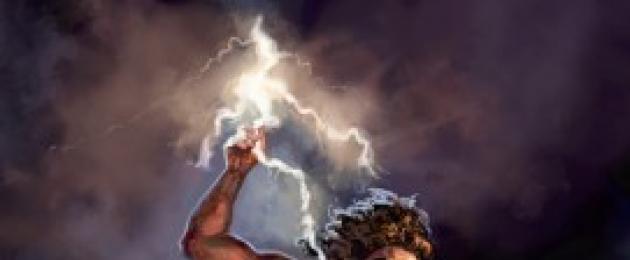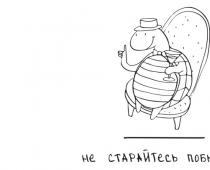Pantheism. The Hellenes deified Pan, the goat-footed, lustful god of nature, who was depicted with a huge erect phallus. It was the phallus that became the symbol of this deity. The Hellenes worshiped him in sacred groves and gardens; fountains in the form of the same phalluses were arranged in his honor; phallic statues, symbols, amulets were widespread; puppets with rising phalluses were obligatory participants in theatrical performances, official celebrations and traditional processions of farmers around the fields, with the goal of increasing the fertility of the land with the help of Pan. A whole host of spirits circled around this god: these are centaurs - the spirits of mountain streams, nymphs - the spirits of meadows, dryads - the spirits of trees, Silenes - the spirits of forests, satyrs - the spirits of vineyards, etc. The agricultural population especially revered Demeter - the “mother of loaves”, and In imitation of her, who became pregnant from a peasant in the field, a ritual of intercourse was performed directly on freshly plowed land, which had a magical meaning - influencing the forces of fertility of the earth.
The Hellenes revered and feared Artemis, the goddess of wild animals. The urban population revered Hephaestus, the god of crafts, patron of blacksmiths, as well as the goddess of wisdom, Athena. Athena was not only the goddess of wisdom, but also the patroness of inventors, artisans, especially potters; It was believed that it was she who created the first potter's wheel. The townspeople also especially singled out Hermes, the god of travel and trade, who protected against thieves; It was believed that he made the first scales, weights, and established measurement standards. Cultural figures worshiped Apollo, the god of the arts, and the muses. The sailors made sacrifices to Poseidon, the god of the sea. All Hellenes united in the worship of Zeus, the supreme god, and Moira, the goddess of fate.
Temples were built for the gods and majestic statues were erected. It was believed that in sacred times the spirit of the gods entered the statues; therefore, the priests performed rituals of washing, dressing, eating and going to bed for the statues; on the days of the summer and winter solstice, rituals of sacred marriage were performed, when the statue of the god was carried to the house of the first archon, put into bed with the archon's wife, and the latter, it was believed, could become pregnant from the god. In Hellas, animal and human sacrifices were performed throughout its history. Themistocles, a contemporary of the 5th century BC, the most enlightened age of Hellas, strangled three of the most beautiful youths with his own hands as a sacrifice on the eve of the Battle of Salamis, and he believed that he had won victory over the Persians only thanks to this sacrifice. In Athens, the most cultural and democratic polis, the crippled, sick, and criminals were always kept in special houses, who were declared “pharmaka,” that is, “scapegoats” in days of disaster and were subject to ritual stoning or burning. On the stage of Hellenic theaters, the real blood of those tragic heroes was shed who, according to the script, were supposed to die - at the last moment, instead of the main actor, an understudy was brought out from among the same outcasts, and he died, becoming a sacrifice to the gods. IN Hellenistic period the cult of sacrifice intensified even more. The phallic cult acquired an unrestrained orgiastic character.
Roman mythology in its initial development it came down to animism, that is, belief in the animation of nature. The ancient Italians worshiped the souls of the dead, and the main motive for worship was fear of their supernatural power. For the Romans, as for the Semites, the gods seemed to be terrible forces that had to be reckoned with, appeasing them by strict observance of all rituals. Every minute of his life, the Roman was afraid of the disfavor of the gods and, in order to secure their favor, he did not undertake or complete a single deed without prayer and established formalities. In contrast to the artistically gifted and active Hellenes, the Romans did not have folk epic poetry; their religious ideas were expressed in a few, monotonous and meager in content myths. The Romans saw only gods will(numen), which interfered with human life.
The Roman gods had neither their own Olympus nor genealogy, and were depicted in the form of symbols: Mana - under the guise of snakes, Jupiter - under the guise of stone, Mars - under the guise of a spear, Vesta - under the guise of fire. The original system of Roman mythology - judging by the data that ancient literature tells us, modified under a variety of influences - boiled down to a listing of symbolic, impersonal, deified concepts, under the auspices of which a person’s life consisted from conception to death; no less abstract and impersonal were the deities of souls, whose cult formed the most ancient basis of family religion. At the second stage of mythological ideas there were deities of nature, mainly rivers, springs and the earth, as producers of all living things. Next come the deities of heavenly space, deities of death and the underworld, deities - personifications of the spiritual and moral aspects of man, as well as various relations of social life, and, finally, foreign gods and heroes. The deities personifying the souls of the dead included Manes, Lemures, Larvae, as well as Genii and Junones (representatives of the productive and vital principle in man and woman). At birth, geniuses move into a person; at death, they separate from the body and become manes (good souls).
In honor of Juno and Genius, sacrifices were made on their birthdays and they were sworn in their name. Later, each family, city, state was given its own Geniuses for protection. The Laras, the patrons of fields, vineyards, roads, groves and houses, are related to the Geniuses; Each family had its own lar familiaris, who guarded the hearth and home (later there were two). In addition, there were special gods of the hearth (actually patrons of the pantry) - Penates, which included, among other things, Janus, Jupiter, Vesta. The deities, under whose protection all human life in all its manifestations was, were called dei indigetes (internally acting or living gods). There were as many of them as there were different activities, that is, an infinite number; every step of a person, every movement and action at different ages was taken care of special gods, lists (indigitamenta) of which were compiled in the 4th century BC. e. pontiffs, with detailed instructions on which deity with which prayer formula and in what cases of life should be addressed. Thus, there were gods who protected a person from the time of conception to birth (Janus Consivius, Saturnus, Fluonia, etc.), who helped at birth (Juno Lucina, Carmentis, Prorsa, Postversa, etc.), who protected the mother and child immediately after birth ( Intercidona, Deus Vagitanus, Cunina, etc.), who took care of children in the first years of childhood (Potina, Educa, Cuba, Levana, Earinus, Fabulinus), gods of growth (Iterduca, Mens, Consus, Sentia, Voleta, Jnventas, etc. .), patron gods of marriage (Juno juga, Afferenda, Domiducus, Virginensis, etc.). In addition, there were deities of activities (especially agriculture and cattle breeding) - for example Proserpina, Flora, Pomona (Proserpina, Flora, Pomona), and places - for example Nemestrinus, Cardea, Limentinus, Rusina. With the further evolution of mythological ideas, some of these deities became more individualized, others were added to their main attributes, and the mythological image became more prominent, approaching the human, and some deities were united in marriage pairs. At this stage of development of religious ideas, the deities of nature appear - gods and goddesses of the water element, fields, forests, as well as some phenomena human life. The deities of the springs (usually goddesses) were revered in the groves and also possessed the gift of prophecy and song, and were also assistants during childbirth. These deities included, for example, Camenae and Egeria - the prophetic wife of Numa. Of the river gods in Rome, Pater Tiberinus was revered, who was propitiated by the sacrifice of the Argeans (27 dolls were made from reeds, which were thrown into the water), Numicius (in Lavinia), Clitumnus (in Umbria), Volturnus (in Campania). The representative of the water element was Neptune, who later, through identification with Poseidon, became the god of the sea (from 399 BC).
The gods whose activity was manifested in nature and life and who had a brighter individuality include Janus, Vesta, Vulcan, Mars, Saturn and other gods of fertility and activity in the plant and animal kingdom. Janus, from being the patron of the door (janua), became the representative of all entrance in general, and then by God started as a result of which the beginning of the day and month (morning - hence Janus Matutinus) and all the calendars, as well as the month January named after him, were dedicated to him, as coinciding with the beginning of the arrival of days. He was called upon at the beginning of every task, especially during sacrifices, and was even considered the principium of everything and the father of the gods. The main sanctuary of the god Janus (Janus Geminus or Quirinus) was located at the northern end of the forum, opposite the temple of Vesta. It was an ancient arch that served as the entrance to the forum (the atrium of Rome). Its gate to war time were revealed; under the arch there was an image of a two-faced god. Another place of his cult was the Janiculum hill, named after him, on which, according to legend, Ancus Marcius erected a fortification to protect the trade route leading to Etruria and the harbors; in this regard, Janus was the patron god of trade and navigation. Related to Janus Matutinus is Mater Matuta, goddess of the dawn, giver of light, assistant in childbirth, and, together with Portumnus, guardian of harbors. Vesta personified the fire that burned in the hearth, both public and private. The cult of the goddess was led by six virgins, named after her by the Vestals. In contrast to Vesta, who personified the beneficial power of fire, Vulcan or Volcanus (Volcanus) was a representative of the destructive fire element. As the god of the elements, dangerous for city buildings, he had a temple on the Campus Martius. He was invoked in prayers and together with the fertility goddess, Maya, and was considered a deity of the sun and lightning. Later he was identified with Hephaestus and began to be revered as the god of blacksmithing and volcanoes.
The main deities who patronized agriculture were Saturn (the god of sowing), Cons (the god of the harvest) and Ops, the wife of Cons. Later, Saturn was identified with the Greek Cronus, Ops with Rhea, and many features of the Greek cult were introduced into the Roman cult of these deities. Agriculture and cattle breeding were also patronized by other gods of forests and fields, who symbolized the forces of nature and were worshiped in groves and at springs. Their attributes and divine properties were as simple as the very life and environment of their worshipers. For everything that was dear and pleasant to the farmer and cattle breeder, they considered themselves obliged to the deities who sent their blessing. This included Faun, with his wife Faun (Bona Dea), a beneficent god, later identified with King Evander; the flight of the priests of Faun, the Luperci, was intended to bring down the blessing of God on people, animals and fields. Silvan (forest god, goblin), who frightened lonely travelers with prophetic voices, was the patron of borders and property; Liber and Libera - a couple who personified the fertility of fields and vineyards - were later identified with the Greek couple Dionysus and Persephone; Vertumnus and Pomona guarded the gardens and fruit trees; Feronia was considered the giver of a bountiful harvest; Flora was the goddess of blossom and fertility; Pales protected pastures and livestock. Diana patronized fertility, as indicated, perhaps, by the combination of her holiday (August 13) with a sacrifice in honor of Vertumnus. In addition, Diana protected slaves, especially those who sought refuge in her grove (near Tusculum, near Aricia), helped women during childbirth, and sent fertility to families; later she became identified with Artemis, becoming the goddess of the hunt and the moon. The deities who sent fertility also included Mars - one of the national gods most revered by the Italians, perhaps the ancient deity of the sun. They turned to him with prayers for the sending of fertility to the fields and vineyards; the so-called sacred spring (ver sacrum) was established in his honor. He was also the god of war (Mars Gradivus); Its military attributes (sacred spears and shield) indicate the antiquity of the cult. The totem of Mars, picus (woodpecker), over time became the god of forests and meadows, the patron of agriculture, and was worshiped, under the name Picumnus, together with Pilumnus, the god of threshing. The Sabine god Quirinus also stands close to Mars; in later legends, Mars was made the father of Romulus, and Quirinus was identified with Romulus. The most powerful of all the mentioned deities were the gods of heaven and air space, Jupiter and Juno: Jupiter - as the god of daylight, Juno - as the goddess of the moon. The thunderstorm was attributed to Jupiter, as among the Greeks - to Zeus; therefore Jupiter was considered the most powerful of the gods. His weapon is lightning; V ancient times in special cults it was even called lightning. He sent fertilizing rains (Elicius) and was revered as the god-giver of fertility and abundance (Liber). In his honor, holidays associated with the grape harvest were established; he was the patron of agriculture, cattle breeding and the younger generation.
On the contrary, atmospheric phenomena that bring danger and death to people were attributed to Veiovis, Vediovis - evil Jupiter; akin to Jupiter, Summanus (sub mane - in the morning) was the god of night storms. As an assistant in battles, Jupiter was called Stator, as a giver of victory - Victor; In his honor, a college of fetials was established, which demanded satisfaction from the enemies, declared war and concluded treaties in compliance with well-known rituals. As a result, Jupiter was called upon to confirm the fidelity of the word, like Deus Fidius - the god of oaths. In this regard, Jupiter was also the patron of boundaries and property (Juppiter Terminus or simply Terminus). The chief priest of Jupiter was the flamen Dialis; Flamin's wife - flaminica - was a priestess of Juno. The cult of Juno was widespread throughout Italy, especially among the Latins, Oscans, and Umbrians; In honor of her, the month Junius or Junonius received its name. As a lunar goddess, all Kalends were dedicated to her; that is why it was called Lucina or Lucetia. Like Juno Juga or Jugalis or Pronuba, she sanctified marriages, like Sospita she protected the inhabitants. Deities underworld did not have that bright individuality that amazes us in the corresponding department of Greek mythology; The Romans did not even have a king of this underworld. The god of death was Orcus; Along with him, the goddess is mentioned - the patroness of the dead - Tellus, Terra mater - who received shadows into her bosom. As the mother of Lares and Manas, she was called Lara, Larunda and Mania; like avia Larvarum - she personified the horror of death. The same religious ideas that created a number of dei indigetes - deities representing individual human actions and activities - gave rise to a number of deities personifying moral and spiritual abstract concepts and human relations. These include Fortuna (Fate), Fides (Loyalty), Concordia (Concord), Honos and Virtus (Honor and Bravery), Spes (Hope), Pudicitia (Bashfulness), Salus (Salvation), Pietas (Kinship Love), Libertas (Freedom). ), Clementia (Meekness), Pax (Peace), etc.
In the imperial era, almost every abstract concept was personified in the image of a woman, with the corresponding attribute. Finally, there were also gods that the Romans adopted from other peoples, mainly from the Etruscans and Greeks. Greek influence was expressed especially strongly after the Sibylline books were brought to Rome from Qom - a collection of Greek oracle sayings, which became the book of revelation of the Roman religion. Greek religious concepts and features of the Greek cult were firmly established in Rome, either merging with related Roman ones, or displacing pale Roman ideas. The struggle between the relief images of the Greek religion and the vague outlines of the Roman religion ended with the fact that Roman mythological ideas almost completely lost their national character, and only thanks to the conservative cult did the Roman religion retain its individuality and influence. Foreign deities include the Etruscan Minerva (Menrva, Minerva), the goddess of thinking and reason, patroness of crafts and arts. Thanks to the comparison with Pallas, Minerva entered the Capitoline triad and had her cella in the Capitoline temple. The difference between Minerva and Pallas was only that the first had nothing to do with the war. Venus was probably the ancient Italian goddess of beauty and prosperity, but in the cult she merged with the Greek Aphrodite. Mercury was originally known as deus indiges - the patron of trade (merx, mercatura), but later, through comparison with Hermes, took on the attributes of the Greek god. Hercules (an adaptation of the Greek Ήρακλής in Latin) became known in Rome with the establishment of lectisternia; the tales about him are entirely borrowed from Greek mythology. The Greek Demeter was known under the name Ceres from 496 BC, whose cult in Rome remained completely Greek, so that even the priestesses at her temple were Greek women. Apollo and Dis pater are also purely Greek deities, of which the latter corresponded to Pluto, as indicated by the comparison of the Latin name with the Greek (Dis = dives - rich = Πλούτων). In 204, the sacred stone of the Great Idean Mother from Pessinunt was brought to Rome; in 186 there was already a Greek holiday in honor of Dionysus-Liber - Bacchanalia; then the cults of Isis and Serapis moved from Alexandria to Rome, and from Persia - the mysteries of the solar god Mithras. The Romans did not have heroes, in the Greek sense, because there was no epic; only a few individual gods of nature, in different localities, were revered as the founders of ancient institutions, unions and cities. This includes the most ancient kings (Faun, Picus, Latinus, Aeneas, Iulus, Romulus, Numa, etc.), depicted not so much as heroes of wars and battles, but as organizers of states and legislators. And in this regard, Latin legends were formed not without the influence of the Greek epic form, in which a significant part of Roman religious material was clothed in general.
A special characteristic feature of these heroes was that, although they seemed to be prehistoric figures, they ended their lives not with death, but with disappearance to an unknown destination (the term non comparuit was included here). Such was, according to legend, the fate of Aeneas, Latinus, Romulus, Saturn and others. The heroes of Italy do not leave offspring behind them, as we see in Greek legends; although some Roman surnames traced their origins to heroes (Fabius - from Hercules, Julia - from Ascanius), no genealogical legends were created from these legends; Only a few liturgical hymns and drinking songs with their echo have survived. Only with the penetration of Greek forms and ideas into the Roman spiritual life did Roman genealogical legends develop, composed and disseminated, for the benefit of the Roman aristocracy, by Greek rhetoricians and grammarians who found shelter in Rome as guests, friends and slaves: teachers and educators. The Roman gods were more moral than the Greek ones. The Romans were able to subordinate all the forces of man to discipline and turn them to one goal - the exaltation of the state; Accordingly, the Roman gods, caring for human life, were defenders of justice, property rights and other human rights. That is why the moral influence of the Roman religion was great, especially during the heyday of Roman citizenship. We find praise for the piety of the ancient Romans in most Roman and Greek writers, especially in Livy and Cicero; the Greeks themselves found that the Romans were the most pious people in the whole world. Although their piety was outward, it proved respect for customs, and the main virtue of the Romans, patriotism, rested on this respect.
Greece is unthinkable without mythology. When we talk about this state, the name Olympus, the sacred mountain where Zeus and other supreme deities reigned, naturally comes to mind. Almighty Gods Ancient Greece - they are immortal, capricious, endowed with the advantages and disadvantages of people. They sin, they love, they take revenge like mere mortals, but at the same time they are formidable, cruel, and sometimes generous.
Legends and myths of Olympus: list and description of 12 gods
Legends about the Olympian gods passed from generation to generation and had a huge influence on world culture. Stories from ancient greek mythology were present in literature, poetry, painting, sculpture, music. They “exerted” influence on almost all spheres of human life, as they reflected people’s ideas about the structure of the world.
The information that has reached our times about the legends and tales of Ancient Greece came from the works of Homer, Ovid, Nonnus, and Euripides. Thus, by the “Olympic” period of the development of society, all myths were associated with Mount Olympus, where 12 deities headed by Zeus sat (although their number does not always coincide).
According to ancient Greek myths, before the “central” Gods ascended to Olympus, Chaos existed on Earth, which gave birth to Eternal Darkness and dark night. From them came the Eternal Light and the bright Day. So, night began to give way to day, and day to night, forever and ever.
The mighty Goddess Gaia (Earth), also emerging from Chaos, gave birth to Sky (Uranus), Mountains and Sea. And then Uranus took Gaia as his wife. From this union six Titans and six Daughters were born. From their connection with each other, rivers, winds, stars, rains, and the Moon appeared in the world.
In addition, Gaia gave birth to three Cyclops giants and three giants, each of whom had 50 heads and 100 arms. Uranus saw these monsters and hated them, since they had a violent character and powerful strength. Uranus imprisoned them in the bowels of the Earth, but she secretly rescued them and persuaded them to rebel against their father. Only one, the youngest of the brothers named Kronos, managed to take power from Uranus.
Then the goddess Night gave birth to death, discord, deception, nightmares, destruction and revenge. Kronos began to rule in a world where struggle, horror and misfortune reigned. This is how Night punished the cunning Kronos.
Most of all, he was afraid that his children could do away with him at any moment, just like he did with his father. And then he called his wife Rhea to him and ordered her to bring the children that were born. The merciless Kronos swallowed all of them - Hestia, Demeter, Hera, Hades and Poseidon. But there was also a sixth child - Zeus. Instead, Rhea gave her husband a stone wrapped in cloth, as if it were a baby in swaddling clothes. And secretly from her ruthless husband, she went to the island of Crete, where she gave birth to a baby in a dark cave.
Zeus
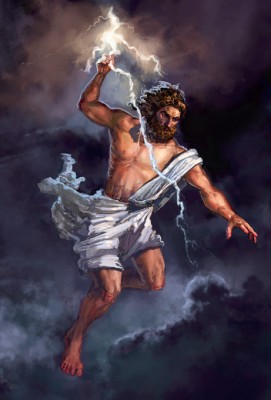 Kronos, the king of the Titans, learned about the forgery and began to look for his son throughout the Earth. The boy was protected by curetes - according to one version, these creatures were born from the tears of little Zeus. They made an incredible noise when he cried, because with his loud voice he could attract the attention of a cruel parent.
Kronos, the king of the Titans, learned about the forgery and began to look for his son throughout the Earth. The boy was protected by curetes - according to one version, these creatures were born from the tears of little Zeus. They made an incredible noise when he cried, because with his loud voice he could attract the attention of a cruel parent.
Zeus grew up, went to war against his father, overthrew him from the throne and imprisoned him in Tartarus - an abyss from which one cannot escape. But first he made him vomit up all the swallowed children, made his brothers and sisters Gods and reigned over the world, sitting on Olympus.
Zeus is the supreme God, patron of Sky, Thunder and Lightning. Artists depict him as a strong and powerful man in years, with rich hair and a gray beard. He sits on a throne and holds a shield and a labrys (double-sided axe) in his hands. The wife of the Thunderer was Hera.
Zeus is often presented as punitive and cruel, but he “arranged” the lives of people, gave them fate, law, conscience and goodness, and in contrast to them - evil and shamelessness. He is the defender of the offended and humiliated, the patron of kings, the formidable guardian of traditions, order in the world and family.
Hera
 Wife of Zeus, chief of the Goddesses of Olympus. She patronizes family ties, keeps family relationships, helps women during childbirth.
Wife of Zeus, chief of the Goddesses of Olympus. She patronizes family ties, keeps family relationships, helps women during childbirth.
Hera is also the daughter of Kronos and Rhea. When she was still a girl, Zeus fell in love with her, and so that she would pay attention to him, he turned into a cuckoo, and Hera caught her. However, in family life she experienced painful jealousy of her husband, who satisfied his sexual hunger with both goddesses and earthly women. She constantly sent disasters and misfortunes to her husband's mistresses.
Hera is the beauty of beauties. Every year she bathed in magical springs to become a virgin again. The Goddess was depicted as a stately and noble lady, with a diadem or crown on her head, with a cuckoo or peacock, sometimes with the head of a horse.
Poseidon
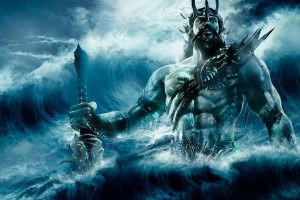 God of the water element, son of Kronos and Rhea, brother of Zeus, patron of fishermen and horse breeders. In character and appearance, Poseidon was similar to his brother the Thunderer. In painting and sculpture he was depicted as a powerful man with strong arms and legs, and a powerful torso.
God of the water element, son of Kronos and Rhea, brother of Zeus, patron of fishermen and horse breeders. In character and appearance, Poseidon was similar to his brother the Thunderer. In painting and sculpture he was depicted as a powerful man with strong arms and legs, and a powerful torso.
His face is never calm, but angry and menacing. Poseidon's constant attribute is the trident. By waving it, the ruler of the seas could cause a storm or, conversely, force the water element to calm down in an instant. Poseidon moves across the sea in a chariot with white horses. His wife is Amphitrite.
Hades
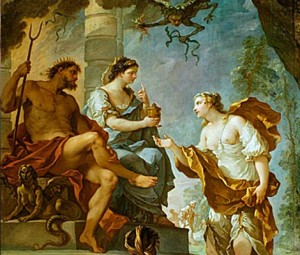 The god of the underworld Hades was the eldest son of Kronos and Rhea. At the same time, he was revered as the patron of the harvest, because everything that grows comes from the depths of the earth. Hades was called “hospitable” because he “waited” and “welcomed” every mortal in his kingdom. Hades was one of the 3 main gods, along with the brothers Zeus and Poseidon, who defeated the Titans.
The god of the underworld Hades was the eldest son of Kronos and Rhea. At the same time, he was revered as the patron of the harvest, because everything that grows comes from the depths of the earth. Hades was called “hospitable” because he “waited” and “welcomed” every mortal in his kingdom. Hades was one of the 3 main gods, along with the brothers Zeus and Poseidon, who defeated the Titans.
The god of the underworld was rarely depicted. If there was an image, then he looked like this: a gloomy man mature age in dark robes, powerful, on a golden throne, with the three-headed dog Cerberus at his feet, guarding the entrance to the kingdom of the dead. Next to Hades was depicted his beautiful wife, the daughter of Demeter and the queen of the dead Persephone, whom he once kidnapped from a flowering meadow. Hades held a bident in his hands (sometimes it was a rod or a cornucopia).
Demeter
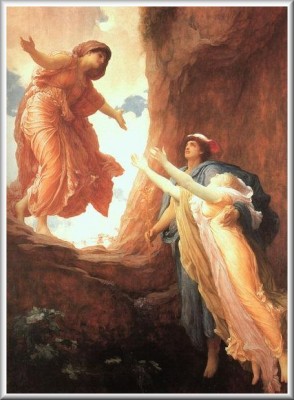 The beginning of Spring was associated with her, the goddess of prosperity and fertility. Demeter's parents are Zeus and Rhea. Demeter has a beautiful appearance and thick light curls. She was mainly revered as the guardian of life and the goddess of agriculture. She was depicted with a basket full of fruits, a cornucopia and a poppy.
The beginning of Spring was associated with her, the goddess of prosperity and fertility. Demeter's parents are Zeus and Rhea. Demeter has a beautiful appearance and thick light curls. She was mainly revered as the guardian of life and the goddess of agriculture. She was depicted with a basket full of fruits, a cornucopia and a poppy.
The most famous legend is about Demeter and her daughter Persephone, who was kidnapped by Hades. The mother left Olympus and wandered the Earth in search of her missing daughter. Demeter grieved greatly for Persephone, even the crops stopped sprouting. Famine set in, people began to die. The gods wondered why people stopped making sacrifices to them, and complained about this to Zeus. Then he sent for Demeter to Earth so that she could be found and returned to Olympus. But she did not want to return to the Gods. Then Zeus ordered Hades to present his daughter to Demeter.
Hades could not disobey his formidable brother, but he came up with a trick so that Persephone would return back to him by adding pomegranate seeds to her. Demeter, seeing her daughter, rejoiced. Zeus ordered Persephone to spend a third of the year with her mother, and the rest of the time with her husband. Mourning for the Mother ended forever, and she decorated her head with a cornflower blue wreath. In honor of the joyful event, the Goddess taught people to sow grain and cultivate wheat. In painting, Demeter was depicted as a girl with a wreath of ears of grain or as a grieving mother.
Apollo
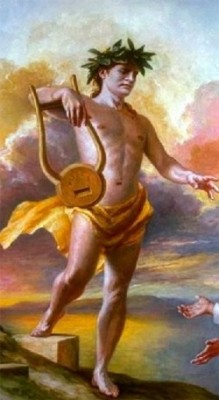 The most beautiful god of Olympus, Apollo, was the son of Zeus and the Titanide Leto. He was incredibly revered in Greece, because he was the patron of art, muses and healing. He is an excellent marksman and a virtuoso musician, which is why he was depicted with a bow and a lyre.
The most beautiful god of Olympus, Apollo, was the son of Zeus and the Titanide Leto. He was incredibly revered in Greece, because he was the patron of art, muses and healing. He is an excellent marksman and a virtuoso musician, which is why he was depicted with a bow and a lyre.
Apollo is young, beautiful and strong: at the Olympic Games he won a fist fight against Ares himself (the God of War). He had no wife, and more than 70 children. Mythology attributes him with numerous relationships with goddesses, mortal women and even young men.
Athena
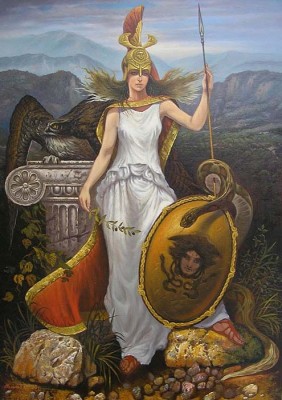 There was also the goddess of war on Olympus - Athena. She personified faith in victory, wisdom and the power of military strategy. Athena patronized the arts, crafts, science and knowledge.
There was also the goddess of war on Olympus - Athena. She personified faith in victory, wisdom and the power of military strategy. Athena patronized the arts, crafts, science and knowledge.
Thanks to her unusual appearance, the goddess of war is easy to distinguish in paintings and sculptures. Her clothes are a linen dress, armor, and a helmet. In her hands there must be a spear, and next to her is a chariot. Athena has a strong-willed face, clear eyes, gray expressive eyes, and long brown hair. Her appearance expresses calm and determination.
It is not entirely clear who Athena’s parents are. According to one version, he was Zeus, who gave birth to her single-handedly.
Hermes
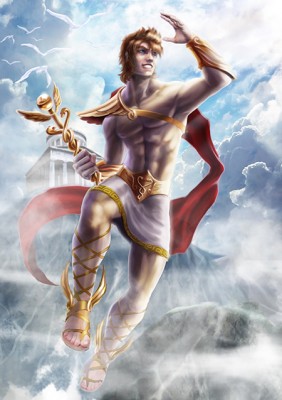 Even the gods of Olympus were no strangers to deceit and deceit. One very handsome, judging by ancient images, a god named Hermes was known as a famous cheat and thief. He was born to the Maya galaxy from Zeus. Being just a baby, Hermes committed his first theft - he stole 50 cows from Apollo. After a good “bashing” from dad, the kid pointed out where he hid the cattle. True, subsequently Zeus more than once turned to the clever child to carry out his orders. One day he asked Hermes to steal a cow from Hera: Io, the beloved of the Thunderer, turned into her.
Even the gods of Olympus were no strangers to deceit and deceit. One very handsome, judging by ancient images, a god named Hermes was known as a famous cheat and thief. He was born to the Maya galaxy from Zeus. Being just a baby, Hermes committed his first theft - he stole 50 cows from Apollo. After a good “bashing” from dad, the kid pointed out where he hid the cattle. True, subsequently Zeus more than once turned to the clever child to carry out his orders. One day he asked Hermes to steal a cow from Hera: Io, the beloved of the Thunderer, turned into her.
Hermes is very inventive: he invented writing, patronizes trade and banking, astrology, alchemy and magic. He conveys “important” messages to people from the gods through dreams. Hermes is young and efficient. He showed signs of attention to Aphrodite, but she rejected him. Hermes has many children, as well as lovers, but no wife. In fine art and sculpture he was depicted wearing a hat with wings and winged sandals.
Hephaestus
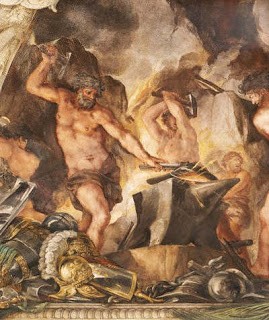 It's not easy with this god. There are several versions of his birth, one of which says that Hera, the wife of Zeus, gave birth to him from her thigh. And she became pregnant herself, not from her husband. So she wanted to take revenge on him for the birth of Athena. However, the baby was born frail, weak and lame. Then Hera, in despair, threw the boy into the depths of the sea, where the sea goddess Thetis sheltered him.
It's not easy with this god. There are several versions of his birth, one of which says that Hera, the wife of Zeus, gave birth to him from her thigh. And she became pregnant herself, not from her husband. So she wanted to take revenge on him for the birth of Athena. However, the baby was born frail, weak and lame. Then Hera, in despair, threw the boy into the depths of the sea, where the sea goddess Thetis sheltered him.
Since childhood, Hephaestus loved to forge: his metal products had no equal either on Earth or on Olympus. Hephaestus is the god of fire and blacksmithing. The most famous legend is about him and about Prometheus, whom the best blacksmith in the world had to chain to a rock by order of Zeus. Hephaestus' wives were Aglaia and Aphrodite.
Aphrodite
 As you know, the goddess of love, beauty and fertility was born from sea foam near the island of Cythera, but was transported by the winds to the shores of the island of Cyprus. One legend says that Aphrodite was conceived by Zeus and Dione, another and more popular that she was born from the seed of castrated Uranus.
As you know, the goddess of love, beauty and fertility was born from sea foam near the island of Cythera, but was transported by the winds to the shores of the island of Cyprus. One legend says that Aphrodite was conceived by Zeus and Dione, another and more popular that she was born from the seed of castrated Uranus.
Aphrodite is the patroness of family ties and childbirth. She was obliged to create love and severely punished those who rejected her. The all-powerful Hera could not forgive Aphrodite for her incomparable beauty and made the ugly Hephaestus become her husband. However, the goddess cheated on her spouse more than once. The most sensational story about Aphrodite was her love for the earthly hunter Adonis.
Aphrodite - "popular" mythological character in the works of ancient sculptors and artists. She is almost never alone in them, for her beauty captivated not only people and gods, but birds and animals. Her companions are nymphs, Eros, harites, dolphins and oras. Sometimes she was portrayed as a naked modesty, sometimes as a flirtatious girl, sometimes as a passionate woman.
Ares
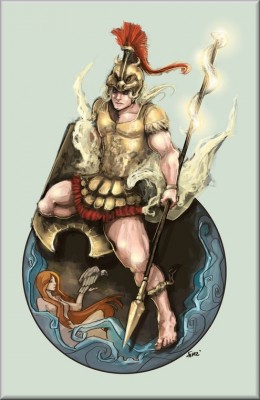 The god of war, Ares, is distinguished by treachery and deceit. If he fought, it was for the sake of war, rather than for justice and honor. Hera and Zeus are considered his parents, although according to one version, Hera gave birth to him without the participation of her husband, but with the help of the power of a magic flower.
The god of war, Ares, is distinguished by treachery and deceit. If he fought, it was for the sake of war, rather than for justice and honor. Hera and Zeus are considered his parents, although according to one version, Hera gave birth to him without the participation of her husband, but with the help of the power of a magic flower.
Zeus did not have paternal feelings for Ares and even hated him. On sacred Olympus, he had difficulty “pushing through” his authority. Ares took part in the Trojan War, but fair Athena defeated him.
In art he was depicted as a young and strong man. Ares was accompanied by dogs and a kite, and in his hands he held a spear and a torch with fire. Ares's wife is Aphrodite.
Artemis
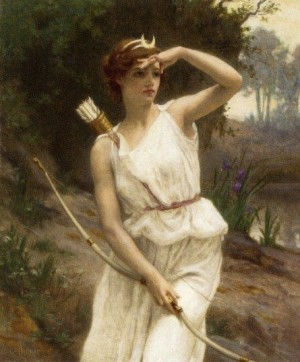 12th place belongs to the goddess of hunting Artemis. She was the protector of virgins, and she herself was innocent, but she patronized those who were married and helped women during childbirth. Artemis was also considered the goddess of fertility and everything that grows on Earth.
12th place belongs to the goddess of hunting Artemis. She was the protector of virgins, and she herself was innocent, but she patronized those who were married and helped women during childbirth. Artemis was also considered the goddess of fertility and everything that grows on Earth.
Artemis was born from the relationship of Zeus with the Titanide Leto. Oceanids and nymphs served her. Despite the fact that she was the patroness of childbirth, Artemis herself was unmarried and childless. Artists and sculptors depicted her as a young woman, dressed in a chiton convenient for hunting, with a spear in her hand, with a bow and quiver on her back. When Artemis appeared naked on Houdon’s canvas, a real scandal broke out. It was late XVIII century.
According to some sources, the list of 12 gods of Olympus was somewhat different: it included Hestia (goddess of the hearth), Dionysus (god of winemaking and fun), Persephone (goddess of Spring, she is also the queen of the Kingdom of the Dead).
Especially for Liliya-Travel.RU - Anna Lazareva
Gaia (or Gaea) was one of the primal potencies (primordial deity) of the earth, one of the basic elements that first appeared at the dawn of creation, along with air, sea and sky.
She was the great mother of all: the heavenly gods came from her union with Uranus (sky), the sea deities from her union with Pontos (sea), the Giants from her mating with Tartaros (hell), and mortal beings were born from her earthly flesh.
In the myth, Gaia appears as the main opponent of the heavenly gods. She first rebelled against her husband Uranus (Sky), who imprisoned her sons in her womb. Then later, when her son Kronos defied her by imprisoning these same sons, she assisted Zeus in the overthrow of the Titan. She finally came into conflict with Zeus, outraged that he had secured her Titan sons in the hell of Tartarus. She first produced a tribe of Giants, and later the monster Typhoeus, to unseat Zeus, but both failed in both attempts. In ancient Greek cosmology, the earth was conceived as a flat disk near the Oceanus River, and was the middle solid level above the dome of heaven and below the hell of Tartarus. She herself had the sea and mountains in her chest.
In Greek art, Gaia was depicted as a pleasant, curvaceous woman, half rising from the earth. She has always been inseparable from her native element. In mosaic art, Gaia appears as a plump woman, often dressed in green, and accompanied by a cup of grain.
Hemera
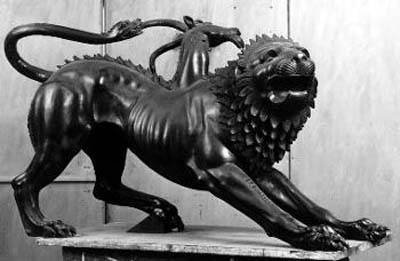
Hemera was the protogen (primitive goddess) of the day. She was the daughter of Erebos (Darkness) and Nyx (Night) and the sister-wife of Aither (Light). In the evening her mother Nyx drew her veil of darkness between aither and aer to bring night to the people. In the morning, Hemera dissipated these mists, revealing the bright blue light of the day. Night and day were regarded as highly independent deities from the sun in ancient cosmogonies.
Hemera was closely identified with Hera, the Queen of Heaven, and the Goddess of the Dawn - Eos. However, Hesiod seems to regard her more as a divine day-substance rather than an anthropomorphic goddess.
PARENTS:
Erebos and Nyx
Erebos
Kronos and Nyx
Chaos
OFFENDER:
Gaia, Uranus, Thalassa (Aiter)
Uranus (Aiter)
"Truly first Chaos (Air) came to be, but then wide embraced Gaia (Earth)... and darkened Tartarus (Hell), hidden deep in the Earth, and Eros (Love), the most just among the immortal gods, who upsets and overcomes the mind and wise councils of all gods and all people. From Chaos (Air) came further Erebos (Darkness) and the black Nyx (Night); but Nyx (Night) gave birth to Aiter (Light) and Hemera (Day), whom she gave birth to out of boredom in union with her lover Erebos. And Gaia (Earth) was at first with the star Uranus (Heaven), equal to her, who covered her on all sides" - Hesiod, Theogony 115.
"Thus at the same time there arose Poros [Kronom?] and Tekmor [Ananke?] and Skotos [Erebos]. Amar (Day) and Melana (Moon) and Skotos (Darkness): days do not simply mean day, but contain the idea of the sun as such, meaning something light. Previously there was only darkness, and subsequently, when it was differentiated, light arose" - Greek. source, Alcman Frag.
"From Caligine (Fog) [was born]: Chaos. From Chaos [was born]: Nox (Night), Diez (Day), Erebus, Ether" - Hyginus, Preface
"From Ether and Diez [were born]: Earth, Caelum, Mare." - Hyginus, Preface In most myths, Hemera is identical to the goddess Eos.
Muses
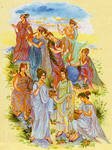
In Greek mythology, the muses are goddesses or deities who embody the arts and the process of creation. They were water nymphs associated with the streams Helicon and Paris; from the latter they are sometimes called Pierides. The system of the Olympian gods established Apollo as their leader, Apollon Mousagetes. Not only are they used on modern English language to turn to inspiration.
According to Hesiod's Theogony (seventh century BC), they are the daughters of Zeus, king of the gods, and Mnemosyne, goddess of memory. For Alcman and Mimnermus, they were even more primordial deities, arising from Uranus and Gaia. According to another source, a rarer theory is that they are the daughters of Harmony (daughter of Aphrodite and Ares), and this theory contradicts the myth in which they danced at the wedding of Harmony and Cadmus.
According to some sources, in the later second century AD there were only three original muses: Aoide ("song" or "voice"), Melete ("practice" or "case") and Mneme. ("memory"). Together, these three form a complete picture of the preconditions of poetic art in cultic practice. At Delphi, three muses were also worshiped, but along with other muses: Nete, Mesi, and Hypate, which are the names of the three chords of the ancient musical instrument, the lyre. They were alternatively called Cephisso, Apollonis, and Borysthenis, names which characterize him as the daughters of Apollo. In later tradition, four muses were recognized: Thelxinoe, Aoede, Arche, and Melete, who were said to be the daughters of Zeus and Plusia (or Uranus). Cicero names a total of seven muses, named Neilo, Triton, Asopo, Heptapora, Achelois, Tipoplo, and Rhodia.
During the Renaissance, the canonical name of the nine muses, with their areas of patronage, was adopted:
. Calliope (muse of epic or heroic poetry)
. Clio (muse of history)
. Erato (muse of love or erotic poetry, lyrics, and marriage songs)
. Euterpe (muse of music and lyric poetry)
. Melpomene (muse of tragedy)
. Polyhymnia (muse of sacred song, eloquence, lyric, chanting and rhetoric)
. Terpsichore (muse of dance)
. Thalia (muse of comedy and bucolic poetry)
. Urania (muse of astronomy)
Greek mousa is a common noun, meaning a type of goddess: it literally means "song" or "poem". The Muses were, therefore, both embodiments and protectors of the beauty of speech: mousike, hence “music,” was “the art of the muses.”
Rhea
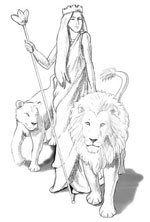
Rhea was the mother of the Titan gods, and the goddess of female fertility, motherhood, and generation. Its name means "flow" and "ease." As the wife of Kronos (Time), she represented the eternal passage of time and generations; as the great Mother (Meter Megale), she represented the "flow" of monthly blood, birth water, and milk. She was also the goddess of comfort and ease, a blessing reflected in Homer's common phrase "gods who live in their ease (rhea)". In myth, Rhea was married to the Titan Cronus and she was the queen of heaven. When her husband heard a prophecy that he would be overthrown by one of his children, he began to swallow each of them as soon as they were born. But Rhea gave birth to her youngest son, Zeus, in secret and hid him in a cave on the island of Crete. And she presented Kronos with a stone wrapped in swaddling clothes, which he quickly swallowed. Rhea was closely comparable to the Anatolian mother goddess Kybele. They were and were depicted as voluptuous women, usually wearing a crown on their heads, and with lions.
PARENTS:
1.1 Uranus and Gaia
1.2 Aiter (or Uranus) and Gaia
OFFENDER:
1.1 Hestia, Demeter, Hera, Hades, Poseidon, Zeus
1.2 Zeus, Poseidon, Hades
1.3 Zeus, Demeter, Hades (Hymn of Homer 2.69)
Rhea (Rheia, Rheiе, or Rhee). The name as well as the nature of this deity is one of the most difficult points in ancient mythology . Some sources believe that Rhea is simply another form of era, earth, while others connect it with rheo, with flow (Plato Cratyl. p. 401); but, therefore, it seems very certain that Rhea, like Demeter, was an earth goddess. According to Hesiod's Theogony, Rhea was the daughter of Uranus and Germania, and respectively the sister of Oceanus, Coe, Hyperion, Krios, Iapetus, Theia, Themis, and Mnemosyne. She and Cronus became the mother of Hestia, Demeter, Hera, Hades, Poseidon, and Zeus. According to some sources, Kronos and Rhea preceded Ophion and Eurynome in the world; but Ophion was suppressed by Cronus, and Rhea threw Eurynomus into Tartarus. Cronus is said to have devoured all his children by Rhea, but when she was about to give birth to Zeus, she, on the advice of her parents, went to Lyctus on the island of Crete. When Zeus was born, she gave Cronus a stone wrapped like a baby, and the god swallowed it as he swallowed his other children. Homer (Il. xv. 187), makes only a passing allusion to Rhea, and Hesiod's account, which accordingly must be regarded as the oldest Greek legend of Rhea, seems to suggest that the mystic priests of Crete had already formed connections with the more northern parts of Greece . In this manner, it would seem that the mother of Zeus became famous among the Thracians, with whom she became a deity of much greater importance than she had previously been in the south (Orph. Hymn. 13, 25, 26), since she was associated with the Thracian the goddess Bendis or Cotys (Hecate), and was identified with Demeter. (Strab. x. p. 470). In Phrygia, where Rhea became identified with Cybele, she is said to have purified Dionysus, and taught him the secrets (Apollod. iii. 5. § 1), and thus the element of the cult of Dionysus became united with the worship of Rhea. Demeter, besides being the daughter of Rhea, is sometimes mentioned with all the attributes belonging to Rhea. (Eurip. Helen. 1304). The disorder then became so great that the religion of the inhabitants of Crete regarding the cult of Rhea was confused with the Phrygian mother of the gods, and in the orgy of Dionysus they began to intertwine with the cult of Cybele. Both Rhea's name and connection to Demeter suggest that she was revered as an earth goddess in earlier times. The island of Crete was undoubtedly the earliest site of the cult of Rhea; Diodorus saw the site where her temple once stood, in the neighborhood of Cnossus, and it seems that she was once worshiped on the island even under the name of Cybele (Euseb. Chron. p. 56; Syncell. Chronogr. p. 125). The general tradition, further, was that Zeus was born on the island of Crete, or in a cave of Mount Dicte. Also, local traditions implying that Rhea gave birth to Zeus in one place or another in Greece occur in various other areas of the country. Some sources explicitly state that he was born in Thebes (Tzetz. Lyc. 1194).
Rhea was revered by various names: “great mother,” “mother of the gods,” Cybele, Agdistis, Berecynthia, Brimo, Dindymene, “great mother of the gods.” In all European countries Rhea was conceived to accompany Curetes, who is inextricably linked with the birth and upbringing of Zeus on the island of Crete. Those who worshiped Curet were her enthusiastic priests who, with drums, cymbals, horns, and in full armor, performed their orgiastic dances in the forests and mountains of Phrygia. The lion was the sacred belly of the mother of the gods because she was the deity of the earth, and because the lion is the strongest and most important of all animals on earth. In Greece, the oak was the sacred tree of Rhea (Apollon. Rhod. i. 1124). Lions were usually depicted crouching to the right of her throne, and she was sometimes seen riding in a chariot drawn by lions.
Demeter
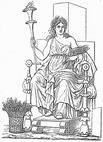
Demeter was the great Olympian goddess Agriculture, grain, and daily bread for humanity. She also exercised control over the foremost of the region's secret cults, whose initiates were promised her protection on the path to a happy afterlife. Demeter was depicted as a mature woman, often wearing a crown and holding a sheaf of wheat and a torch.
The most famous myths of Demeter:
The abduction of her daughter Persephone by Hades;
Departure of Demophoon, young son of King Keleus of Eleusis;
The Journeys of Triptolemos, a hero sent by the goddess to instruct humanity in agriculture;
Her rape by Poseidon, who forcibly copulated with her, appearing before her in the form of a horse; and etc.
PARENTS: Kronos and Rhea
Demeter, one of the most deities of the Greeks. Demeter is the name of Tho, as some authors suggest is the same as ge meter, that is, mother earth, while others consider Deo, which is synonymous with Demeter, and is derived from the Cretan the words deai, barley, that is, Demeter was the mother or giver of barley or food in general. These two etymologies, however, do not suggest a difference in the character of the goddess. Demeter was the daughter of Kronos and Rhea, and the sister of Hestia, Hera, Hades, Poseidon, and Zeus. Like Cronus's other children, she was devoured by her father, but he snatched his children and her away, also after Metis gave him an emetic. (Hesiod. Theog. 452,; Apollod. 2. § 1). From her brother Zeus Demeter gave birth to Persephone (Proserpine) and Dionysus (Hesiod, Theoq. 912; Diod, iii. 62), and from Poseidon she gave birth to Despoena and the horse Arion. The most famous part in the myth of Demeter is the violent theft of her daughter Persephone by Pluto, and this story not only suggests main idea, embodied in Demeter, but also directs our attention to the main places of her cult. Zeus, without notifying Demeter, promised Persephone to Pluto, and while the unsuspecting maiden was gathering flowers that Zeus had created to seduce her and approve of Pluto's scheme, the earth suddenly opened up and she was stolen by Hades (Pluto). Her cries of agony were heard only by Hecate and Helios. Her mother, who only heard the echo of her voice, immediately began searching for her daughter.
It is clear where Persephone was believed to have been taken to the nether world varies in different traditions and myths; general history places this place in Sicily, in the vicinity of Enna, on Mount Etna, or between the wells of Cyane and Arethusa. This legend, which points to Sicily, although undoubtedly very ancient, is certainly not original, since the cult of Demeter was introduced to Sicily by colonists from MegaRa and Corinth. Other traditions place Persephone's theft at Erineus on Cephissus, in the vicinity of Eleusis, at Colon in Attica near the west coast of Spain, at Hermione in the Peloponnese, or in the vicinity of Pisa. The Iliad and Odyssey clearly do not mention the fact of Persephone's theft. Demeter wandered in search of her daughter for nine days, without taking nectar or ambrosia, and without bathing. On the tenth day, she met Hecate, who told her that she had heard Persephone's cries, but did not know who had stolen her. Both then hurried to Helios, who told them that Pluto was a thief with the consent of Zeus. Demeter fled from Olympus in anger, and remained on earth among men, bestowing gifts and blessings wherever she was kindly received, and severely punishing those who did not accept her. Because the goddess was angry, she caused a famine on the earth, not allowing any fruit to grow, Zeus, worried that humans might become extinct, sent Iris to encourage Demeter to return to Olympus. But in vain. Zeus sent all the gods of Olympus to reconcile her with requests and gifts; but she vowed neither to return to Olympus nor to restore the abundance of the earth until she saw her daughter again. Zeus accordingly sent Hermes to Erebus to take Persephone back. Hades agreed for Persephone to return, but gave her a pomegranate seed so that she could not stay with Demeter forever. Hermes took her in a chariot and brought her to her mother. Zeus sent Rhea to persuade Demeter to return to Olympus, and after that Persephone had to spend part of the year (i.e. winter) in underground darkness, and the rest of the year she had to stay with her mother.
Demeter was worshiped on the island of Crete, Tilos, Argolis, Attica, the western coast of Asia, Sicily and Italy, and her cult consisted largely of orgies and mysterious processions.
Summer
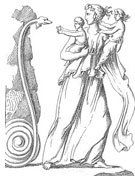
Leto was one of the female Titanides, the bride of Zeus, and the mother of the twin gods Apollo and Artemis. She was the goddess of motherhood and with her children, she protected youth. Her name and iconography suggest that she is also the goddess of feminine modesty. Like her sister Asteria, she may also have been a goddess of the night. When Leto was pregnant with her twins, she was pursued relentlessly by the goddess Hera, who forced her to leave the solid earth and prevented her from finding a place where it was possible to rest and give birth. The floating island of Tilos eventually provided her with refuge. Later, when she was traveling to Delphi, the giant Tytos tried to kidnap her, but Apollo intervened and killed him with his arrows. In Greek art, Leto was usually depicted as a woman removing her shawl as a gesture of modesty. She was usually depicted accompanied by her two children.
PARENTS: 1. Koyo and Phobe.
OFFENDER: Apollo and Artemis (from Zeus)
Leto, in Latin LATONA, according to Hesiod (Theog. 406, 921), daughter of the Titan Coio and Phobe, sister of Asteria, and was the mother of Apollo and Artemis, having given birth to them by Zeus, to whom she was married before Hera. Homer, who similarly calls her the mother of Apollo and Artemis, mentions her as a friend of the Trojans in the war with the Greeks. In the works of later authors, these elements of her story are handled and embellished differently, since they do not describe her as the legal wife of Zeus, she is described simply as a mistress who was pursued during her pregnancy with Hera. The whole world was afraid that she was pursued by Hera, and she wandered until she came to the island of Tilos, which was then a floating island, and had the name of Asteria; but when Summer touched him, he suddenly stood on four pillars and was attached to the bottom. According to Hyginus, Tilos was formerly called Ortygia, while Stephanus of Byzantium mentions the tradition that Artemis was not born on Tilos, but in Corissus. Servius, connects the following legends: Zeus changed Leto, and she arrived on a floating island, which was called Ortygia; or, Zeus was fascinated by Asteria.
Leto gave birth to Apollo, and he killed Python, who was pursuing his mother. But despite many inconsistencies, especially regarding the place where Leto gave birth to her children, most traditions agree in describing Tilos as that very place. After the birth of Apollo, his mother, unable to nurse him, Themis gave him nectar and ambrosia; and with his birth the island of Tilos became sacred, so that henceforth on this island it was not lawful for any other person to be born or die; and every pregnant woman was transferred to the neighboring island of Rheneia, so as not to pollute Tilos.
Hestia

Hestia was the virgin goddess of the hearth and home. As the goddess of the family hearth, she also exercised control over the baking of bread and the preparation of family meals. Hestia was also the goddess of sacrificial flame. Cooking a communal banquet of sacrificial meat was naturally part of her cult. In myth, Hestia was the first born child of Cronus and Rhea, who was swallowed by her father at birth. Zeus later forced the old Titan to disgorge Hestia and her siblings. As the first to be swallowed by Kronus, she was also the last to be disgorged, and was thus named as both the eldest and youngest of the six Kronides. When the gods Apollo and Poseidon sought her hand in marriage, Hestia refused and asked Zeus to allow her to remain an eternal virgin. He agreed, and she took her place in his royal hearth. Hestia was depicted as a modestly dressed woman, sometimes holding a branch with a flower (of a chaste tree?). In classical sculpture it was also hidden, with a teapot (its sign).
PARENTS: 1. Kronos and Rhea; 2. Kronos; 3. Rhea.
Hestia (Histia), goddess of the hearth, or rather of the fire burning in the hearth, was regarded as one of the twelve great gods, and accordingly as the daughter of Cronus and Rhea. According to general tradition, she was born first to Rhea, and was therefore the first of the children to be swallowed by Cronus. She was, like Artemis and Athena, a divine maiden, and when Apollo and Poseidon laid their desire on her hand, she swore by the head of Zeus that she would remain a virgin forever. Based on this, her sacrifices consisted of cows that were only one year old. The connection between Hestia and Apollo and Poseidon referred to in the legend also appears in the temple of Delphi, where the three gods were worshiped together, and both Hestia and Poseidon appeared together also at Olympia. Since the hearth was seen as the sacred center of family life, thus Hestia was the goddess of family life and the giver of inner happiness and blessings, and she was also believed to live in the interior of every house, and invented the art of constructing buildings. In this respect she appears often together with Hermes, who was analogously deus penetralis, as a protector of man's works. Since the hearth of the home is at the same time the altar on which sacrifices are offered to the inner gods (hestiouchoi or ephestioi), Hestia was seen as the presiding officer of all sacrifices, and, as the goddess of the sacred fire of the altar, she took part in the sacrifices in all the temples of the gods.
Therefore, when sacrifices were offered, she was called first and the first part of the sacrifice was offered to her. Solemn vows were made for the goddess of the hearth, and the hearth itself was a sacred refuge where petitioners asked for protection for the inhabitants of the house. The polis or city is just an extended family, and therefore had likewise its sacred hearth, a symbol of a harmonious community of citizens and common worship. This public center usually existed in the prytaneium of the city (public general area city), where the goddess had her special refuge (thalamos), called Prutanitis, with a statue and a sacred hearth. There sacrifices were presented to her. Since this public center was a sacred refuge in every city, the state usually received its guests and foreign ambassadors there. When the colony was sent away, the emigrants took the fire that was to burn on the hearth of their new home from the mother city.
Artemis
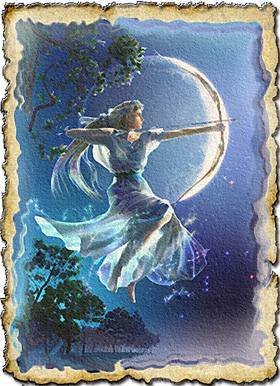
Artemis was the great Olympian goddess of the hunt, wilderness and wild animals. She was also the goddess of fertility, and the protector of girls before the age of marriage. Her twin brother Apollo was also the protector of boys. Together these two gods were also the gods of sudden death and disease. Artemis was usually depicted as a girl with a hunting bow and arrows.
Some of the most famous myths about Artemis include:
Her birth, in which she assisted her mother in the subsequent birth of her twin brother Apollo;
the Trojan War, where she was defeated by Hero in an angry competition of gods;
Hunter Aktaion, who encountered the goddess while she was bathing and was turned into a deer;
The giant Orion, a close companion of the goddess who was killed by the goddess or her jealous brother;
The nymph Callisto, companion of Artemis who was seduced by Zeus, disguised as a goddess.
PARENTS: 1. Zeus and Leto; 2. Demeter
OFFENDER: the goddess had no children, she was a virgin goddess
Artemis is one of the Greek deities. Her name is usually associated with the word artemes (uninjured, healthy, energetic); according to which she was a goddess who did not violate anything on her own and was energetic, and also provides strength and health to others. According to Homer and Hesiod (Theog. 918) she was the daughter of Zeus and Leto, whence Aeschylus calls her letogeneia. She was the sister of Apollo, and helped give birth to him on the island of Tilos. According to another tradition, Artemis was the daughter of Demeter, not Leto, while according to Egyptian history, she was the daughter of Dionysus and Isis, and Leto was only her nurse. But these and some other legends are only the result of the identification of the Greek Artemis with other local or foreign deities. The place of her birth is, for the same reason, different in all the stories: some say it was the grove of Ortygia near Ephesus; and others say that it was the island of Crete, and others again say that she was the sister of Apollo, but born somewhat earlier, so as to help Leto give birth to Apollo.
In describing the nature and character of this goddess, it is necessary to distinguish between different points of view:
1. Artemis, as the sister of Apollo, is a kind of female Apollo, that is, she, as a female deity, represented the same idea as Apollo. This relationship between the two gods is found in many sources described as that of husband and wife, and was the tradition that actually described Artemis as the wife of Apollo. In the character of Apollo's sister, Artemis resembles her brother, armed with a bow and arrow, and sends plague and death among men and animals. Because Apollo was not only a destructive god, but also prevented the evil that was in his power, thus Artemis was at the same time thea soteira; that is, she cured and alleviated the suffering of mortals. Thus, for example, she healed Aeneas when he was wounded and took him to the temple of Apollo. In the Trojan War, she joined the Trojans, like Apollo.
2. Arcadian Artemis is a nymph goddess, and she was also worshiped in Arcadia in a very early times. Her sanctuaries and temples were more numerous in this country than in any other part of Greece. There was no connection between the Arcadian Artemis and Apollo. In Arcadia she hunted with her nymphs; Twenty nymphs accompanied her during the persecution, and with sixty others, daughters of Ocean, she held her dances in the forests of the mountains.
3. Taurian Artemis. The legends about this goddess are mystical, and her cult was orgiastic and bonding, according to at least in the old days, with human casualties. According to Greek legend there was a goddess in Tauria, whom the Greeks for some reason identified with their own Artemis, and to whom all the strangers who were washed up on this coast were sacrificed.
4. The Ephesian Artemis was a deity completely different from the Greek goddess of the same name. She seemed to be nature personified.
Athena
ATHENA (or Athena) was the great Olympian goddess of wise counsel, war, defense of cities, heroic endeavor, weaving, pottery and other crafts. She was depicted crowned with a decorated crest, armed with a shield and spear, and wearing an Aegean cloak wrapped around her chest and arm, adorned with the monstrous head of a Gorgon.
The most famous myths about Athena include:
Her birth from the head of Zeus;
Her competition with Poseidon for the dominion over Athens, in which she produced the first olive tree and he his first horse;
War of the Giants;
Helping Perseus in his quest to kill the Gorgon, and the Argonauts in their search for the Golden Fleece;
Help Hercules in his twelve labors;
Blinding Theseus in order to view her naked in the bath;
The Judgment of Paris, in which she competed with Hera and Aphrodite for the prize of the golden apple;
Trojan War, where she joined the Greeks in battle.
PARENTS: 1. Zeus and Metis; 2. from the head of Zeus
OFFENDER: she had no children, since she was a virgin goddess.
Athena (Athene or Athena), one of the great deities of the Greeks. Homer calls her the daughter of Zeus, without any allusion to her mother or to the manner in which she was begotten, while most later traditions agree in stating that she was born from the head of Zeus. According to Hesiod, Metis, the first wife of Zeus, was the mother of Athena, but when Metis was pregnant with her, Zeus, on the advice of Gaia and Uranus, swallowed Metis, and Athena herself was subsequently born, who arose from his head. (Hesiod, l. c. 924). Pindar adds that Hephastus split the head of Zeus with his axe, and that Athena arose with a mighty war cry. Others say that Prometheus or Hermes or Palamon assisted Zeus in the birth of Athena, and mention the river Triton as the place where the incident took place. (Apollod. 4. § 6; Pind. Ol. vii. 66). Other traditions say that Athena emerged from the head of Zeus in full armor. All these traditions, however, agree on one thing, that Athena is the daughter of Zeus; but there are also sources that say that she is the daughter of Pallus, a winged giant, whom she subsequently killed because of his attempt to violate her chastity, whose skin she used as her aegis, and whose wings she attached to her own feet. The third tradition takes us to Libya, and calls Athena the daughter of Poseidon and Tritonina. Athena, as Herodotus says (iv. 180), on one occasion became angry with her father and went to Zeus, who made her his own daughter. This approach shows more clearly than any other the manner in which authentic and ancient Greek myths were transferred to Libya, where they were subsequently regarded as Greek sources. In Libya she was also said to have invented the flute. The connection of Athena with Triton and Tritonina subsequently gave rise to various conjectures about her place of birth, so that wherever there was a river or spring that had a similar name, on the island of Crete, Thessaly, Boeotia, Arcadia, and Egypt, the inhabitants of these areas claimed that Athena was born in their region. These various stories about Athena arose, as in most other cases, from local legends and from identifications of the Greek Athena with other deities. The general concept that the Greeks told about it, and which was most widespread in ancient world, was that she was the daughter of Zeus.
From this fundamental idea may be derived the various aspects under which it appears in the ancient authors. She seems to have been a deity of an ethical character, and not a representative of a specific physical power manifest in nature; her power and wisdom appear in the fact that she was the protector and operator of the creation of reserves of the state and social institutions. As protector of agriculture, Athena is represented as the inventor of the plow and rake: she created the olive tree, Attica's greatest blessing, taught the people how to operate oxen collars and the plough, took care of the breeding of horses, and instructed the people how to tame horses.
Aphrodite
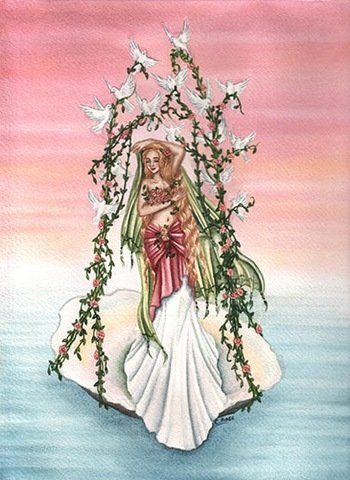
APHRODITE was the great Olympian goddess of beauty, love, pleasure and generation. She was depicted as a beauty, usually accompanied by the winged deity Eros (Love). Her signs included a dove, an apple, a shell and a mirror. In classical sculpture and frescoes she was often depicted naked.
Some of Aphrodite's most famous myths include:
Her birth from sea foam;
Her guilt is in adultery, relationship with the god Ares;
Her love for Adonis, a handsome young man is tragically killed by a hog;
Her love for Ankhises, the shepherd prince;
The Judgment of Paris, in which the goddess received golden apples as a reward in exchange for Paris, left to Helen;
the Trojan War, in which she supported her favorites Paris and Aeneas, and was wounded in the struggle;
the Race of Hippomenes, which was won with the help of the goddess and her golden apples;
Death of Hippolytos, who was killed by the goddess because he despised her cult;
Statue of Pygmalion, who was brought to life by Aphrodite in answer to his prayer;
PARENTS:
Born from the castrated genitals of Uranus in the foam of the sea (Hesiod's Theogony 188, Cicero's De Natura Deorum 3.21, and others)
Zeus and Dion (Homer's Iliad 5.370; Euripides, Cicero De Natura Deorum 3.21, and others)
Uranus and Chimera (Cicero De Natura Deorum 3.21)
Aphrodite, one of the greatest deities of the Olympians, was, according to the popular and poetic concepts of the Greeks, the goddess of love and beauty. Some traditions state that she arose from the foam of the sea that gathered around the mangled pieces of Uranus that were thrown into the sea by Cronus after he defeated his father. (Hesiod. Theog. 190). With the exception of Homer's hymn to Aphrodite, there is not a single trace of this legend in the works of Homer, and according to him, Aphrodite is the daughter of Zeus and Dion. (Il. v. 370, &c., xx. 105). Later traditions call her the daughter of Kronos and Euonyme, or Uranus and Chimera.
According to Hesiod and Homer's hymn about Aphrodite, the goddess, after rising from the foam, first approached the island of Cythera, and from there she moved to the island of Cyprus, and as she walked, flowers appeared under her feet on the coast, and Eros and the Chimeras accompanied her to an assembly of other great gods, all of whom were amazed with admiration and love when she appeared, and her excellent beauty made her desirable, and every god wanted her as a wife.
According to the ideas of natural cosmology, Aphrodite was the personification of nature, and the mother of all living beings. But according to the widespread opinion of the Greeks and their poetic descriptions, she was the goddess of love, who stirred this passion in the hearts of gods and men, and with this power ruled over all living creatures.
Hera
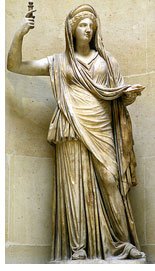
Hera was the queen of the Olympian gods and the goddess of women and marriage. She was also the goddess of the sky and starry skies. Hera was usually depicted as a beauty wearing a crown and holding a royal lotus. Sometimes she held a royal lion or a cuckoo or a hawk.
Some of Hera's most famous myths include:
Her marriage to Zeus and her earlier seduction under the guise of a crazy bird;
The birth of Hephaistos, whom she threw from heaven in order to harm him;
Her pursuit of Zeus's other consorts, especially Leto, Semil and Alcmene;
Her pursuit of Hercules and Dionysus, the most privileged of the illegitimate sons of Zeus;
Ixion, who was chained to a flaming wheel for attempting to violate the goddess;
Helping the Argonauts in their quest for the Golden Fleece, their leader Jason was one of her favorites;
The Judgment of Paris, in which she competed against Aphrodite and Athena for the prize of golden apples; the Trojan War, in which she helped the Greeks.
Parents: Kronos and Rhea (Homer's Iliad 15.187, and others)
Offspring:
Hebe, Ares, Eilithia (EILEITHYIA) (with Zeus) (Theogony of Hesiod 921, Iliad of Homer, and others)
Hephaestios (no father) (Hesiod's Theogony 921, Homer's Iliad, and others)
Typhaon (TYPHAON) (no father) (Hymns of Homer 3.300)
KHARITES (Colluthus 88 & 174)
Hera (Hera or Here) is probably identical with kera, mistress, just as her husband, Zeus, was called erros in the Aeolian dialect (Hesych. s.v). The origin of her name can possibly be traced in a variety of ways, from Greek and Oriental roots, although there is no reason to seek help from the latter, since Hera is simply a Greek goddess, and one of the few who, according to Herodotus (ii. 50), is not was introduced to Greece from Egypt. Hera was, according to some sources, the eldest daughter of Cronus and Rhea, and the sister of Zeus. However, according to many other sources, Hestia was the eldest daughter of Cronus; and Lactantius calls her sister - the twin of Zeus. According to the verses of Homer, she was raised by Oceanus and Tethys because Zeus usurped the throne of Cronus; and later she became the wife of Zeus.
Being the daughter of Cronus, she, like the other children, was swallowed by her father, but was subsequently freed, and, according to Arcadian tradition, she was raised by Temenus, the son of Pegasus (Pelasgus). The Argives, on the other hand, said that she was raised by Euboea, Prosymne, and Acrae, the three daughters of the river Asterion. Her marriage to Zeus also offered ample scope for poetic invention (Theocrit. xvii. 131, &c), and several places in Greece claimed the honor of being the scene of the marriage. This marriage plays a prominent role in Hera's faith called hieros gamos; in this case, all the gods honored the bride with gifts, and Germanius presented her with a tree with golden apples.
Hecate
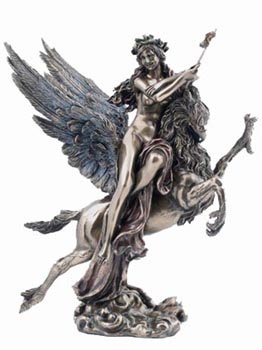
PARENTS:
Persian and Asteria (Hesiod's Theogony 404, Apollodorus 1.8)
Zeus and Asteria (Musaeus Frag, Scholiast on Apollonius Rhodius 3.467)
Nyx (NYX) (Bacchylides Frag 1B, Scholiast on Apollonius Rhodius 3.467)
Aristaios (Pherecydes Frag, Scholiast on Apollonius Rhodius 3.467)
Demeter (Orphic Hymns Frag, Scholiast on Apollonius Rhodius 3.467)
OFFENDER:
none (she was a virgin goddess) (Apollonius Rhodius 3.840, Lycophron 1174)
SKYLLA (Phorkys) (Apollonius Rhodius 4.827)
Kirke (KIRKE), Medea (MEDEA), Aigialus (AIGIALEUS (Aeetes)) (Diodorus Siculus 4.45.1)
Hecate, a mysterious deity who, according to the most common tradition, was the daughter of Persian and Asteria, and it is because of this that she is called Perseis. (Apollod. I. 2. § 4; Apollon. Rhod. iii. 478). Other sources describe her as the daughter of Zeus and Demeter, and state that she was sent by her father in search of Persephone (Schol. Tleocrit. ii. 12); other sources say that she was the daughter of Zeus or Persian or Hera; and finally, there are sources that say that she was the daughter of Leto or Tartarus. Homer doesn't mention her.
According to most authentic traditions, she seems to have been an ancient deity of the Thracians, and was a Titan who, since the time of the Titans, ruled over the heavens, on earth, and in the sea, who was responsible for the wealth of mortals, victory, wisdom, luck to sailors and hunters, and the prosperity of the youth, and the fruitfulness of the cattle. She was the only one of the Titans who retained this power during the reign of Zeus, and she was honored by all the immortal gods. She also helped the gods in their war against the Giants, and killed Clytius. This vast power possessed by Hecate was probably the reason that she was subsequently confused and identified with several other deities and became a mystical goddess. Because she was the patroness of all nature, we find her identified with Demeter, Rhea (Sibyl or Brimo); being a hunter and protector of youth, she is also identified with Artemis; and as the goddess of the moon, she is mystically compared to Persephone.
Persephone

Persephone (P e r s e j o n h); Kora (K o r a, “girl”, “maiden”) · goddess of the kingdom of the dead. Daughter of Zeus and Demeter, wife of Hades, who, with the permission of Zeus, kidnapped her (Hes. Theog. 912-914).
The Homeric hymn “To Demeter” tells how Persephone and her friends played in the meadow, collecting irises, roses, violets, hyacinths and daffodils. Hades appeared from a cleft in the earth and whisked Persephone away on a golden chariot to the kingdom of the dead (Hymn. Hom. V 1-20, 414-433). The grieving Demeter sent drought and crop failure to the earth, and Zeus was forced to send Hermes with the order to Hades to bring Persephone into the light. Hades sent Persephone to her mother, but forced her to eat a pomegranate seed so that Persephone would not forget the kingdom of death and return to him again. Demeter, having learned about the treachery of Hades, realized that from now on her daughter would spend a third of the year among the dead, and two thirds with her mother, whose joy would return abundance to the earth (360-413).
Persephone wisely rules the kingdom of the dead, where heroes penetrate from time to time. The king of the Lapiths, Pirithous, tried to kidnap Persephone together with Theseus. For this, he was chained to a rock, and Persephone allowed Hercules to return Theseus to earth. At the request of Persephone, Hercules left the cow shepherd Hades alive (Apollod. II 5, 12). Persephone was moved by the music of Orpheus and returned Eurydice to him (however, due to the fault of Orpheus, she remained in the kingdom of the dead; Ovid. Met. X 46-57). At the request of Aphrodite, Persephone hid the baby Adonis with her and did not want to return him to Aphrodite; according to the decision of Zeus, Adonis had to spend a third of the year in the kingdom of the dead (Apollod. III 14, 4).
Persephone plays a special role in the Orphic cult of Dionysus-Zagreus. From Zeus, who turned into a serpent, she gives birth to Zagreus (Hymn. Orph. XXXXVI; Nonn. Dion. V 562-570; VI 155-165), who was subsequently torn to pieces by the Titans. Persephone is also associated with the Eleusinian cult of Demeter.
In Persephone, the features of the chthonic ancient deity and classical Olympianism are closely intertwined. She reigns in Hades against her will, but at the same time she feels like a completely legitimate and wise ruler there. She destroyed, literally trampling, her rivals - the beloved Hades: the nymph Kokitida and the nymph Minta. At the same time, Persephone helps the heroes and cannot forget the earth with her parents. Persephone, as the wife of the chthonic Zeus the serpent, dates back to the deep archaic, when Zeus himself was still the “Underground” king of the kingdom of the dead. The vestige of this connection between Zeus Chthonius and Persephone is the desire of Zeus that Hades kidnap Persephone against the will of Persephone herself and her mother.
In Roman mythology, she corresponds to Proserpine - the daughter of Ceres.\from the Internet\
The mythology of Ancient Greece was of great importance for humanity and, first of all, for the development of culture. Ancient peoples were characterized by polytheism, that is, polytheism. The Greek gods were similar to ordinary people, since they did not have immortality and had vices. They lived on the very high mountain Olympus, where they couldn’t get there ordinary people. In mythology there are many gods who had their own purpose and significance for humans.
Important gods of Greek mythology
The most important thing on Mount Olympus was Zeus, who was considered the almighty father of the gods. He was the patron of wind, thunder, lightning and other natural phenomena. He had a scepter, thanks to which he could cause storms and also calm them. Other important deities:
- Greek Helios could see everything that was happening in the Universe, so he was often called all-seeing. The Greeks turned to him to find out important information. Helios was depicted as a young guy with a ball in one hand and a cornucopia in the other. One of the ancient seven wonders of the world is the Colossus of Rhodes, which is a statue of Helios. Every morning, the sun god rode into the sky in his chariot drawn by four winged horses and gave people light.
- Greek god Apollo was the patron of many areas: medicine, archery, creativity, but most often he was called the god of light. His constant attributes are: lyre, larv and plectrum. As for animals, swans, wolves and dolphins were considered sacred to Apollo. This god was depicted as a young guy who always had a bow in his hands, since he was an excellent shooter, and a lyre. Various holidays and festivals were held in honor of this god.
- God of dreams in Greek mythology - Morpheus. He had the ability to penetrate people's dreams, and in the form of any person. Thanks to his powers, the God of Sleep thoroughly copied his voice, habits and other qualities. Morpheus was imagined as a slender young man who had wings on his temples. There are a small number of images of this god in the form of an old man with a poppy in his hands. It was this flower that was a constant attribute of Morpheus, since it had soporific properties. The emblem of this god was the twin gates to the world of dreams. One half was made from Ivory and she opened the entrance to false dreams, and the other half of the horns was responsible for true dreams.
- God of healing in Greek mythology - Asclepius. In many images he is represented as an old man with a large beard. His attribute is a staff that entwines a snake, symbolizing the eternal rebirth of life. Image of a staff before today considered a symbol of medicine. He knew all the medicinal properties of plants, discovered antidotes for bites, and also developed surgery. In honor of Asclepius, many temples were created, which certainly had a hospital.
- Greek god of fire - Hephaestus. He was considered the patron of blacksmithing. He made various products that were used by other gods of Olympus. Hephaestus was born a sick and lame child. That is why his mother Hera threw him from Olympus. Hephaestus's products were not only durable, but also beautiful and as believable as possible. The god of fire was depicted as an ugly, but broad-shouldered man.
- Greek was the ruler of the underworld. People did not consider him evil and portrayed him as a powerful older man. He had a big beard. In general, he was very similar to his brother Zeus. This god had several attributes. The main thing was the helmet, which gave invisibility. In his hands, Hades held a two-pronged pitchfork or a scepter with the heads of three dogs. Wild tulips were considered a symbol of the god of the underworld. The Greeks sacrificed black bulls to Hades.
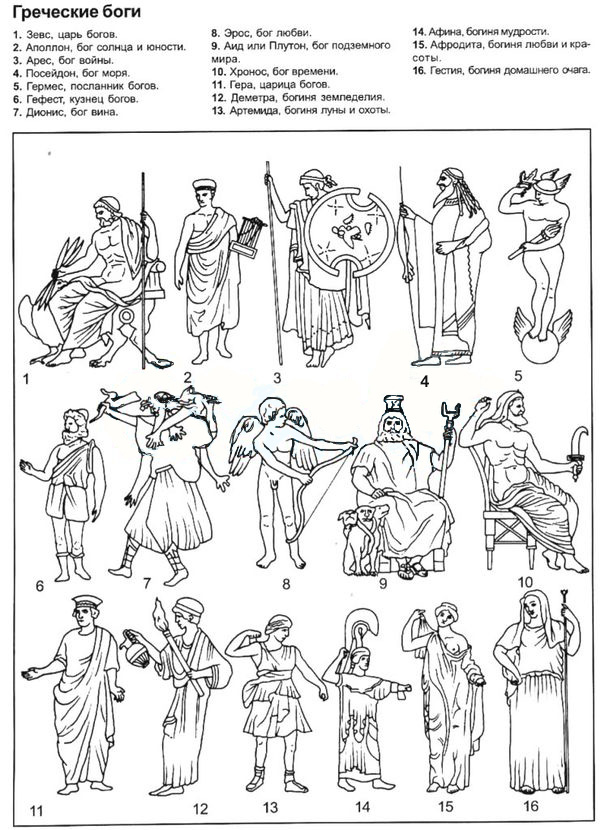
- God is the ruler of the kingdom of the dead, as well as the kingdom itself. One of the elder Olympian gods, brother of Zeus, Hera, Demeter, Poseidon and Hestia, son of Kronos and Rhea. Husband of the fertility goddess Persephone
- In contact with 0
- Google+ 0
- OK 0
- Facebook 0

